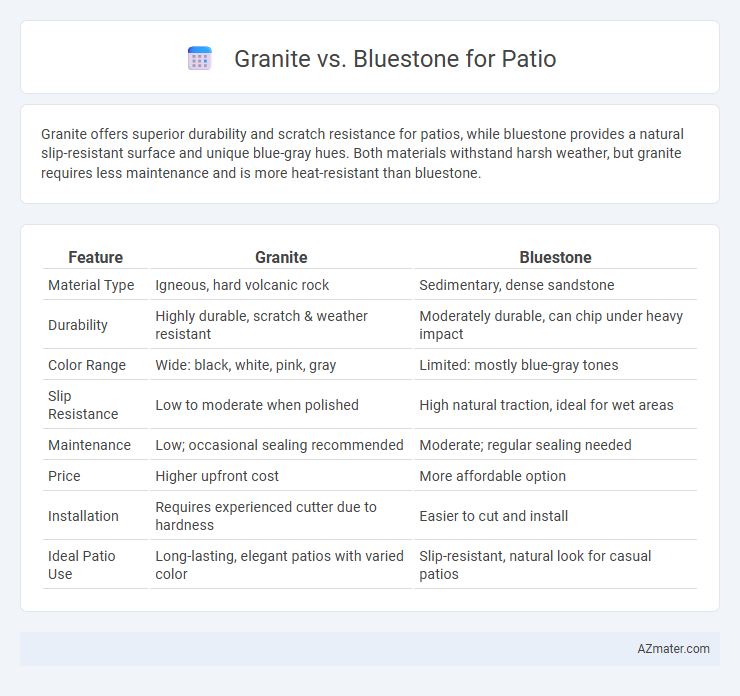Granite offers superior durability and scratch resistance for patios, while bluestone provides a natural slip-resistant surface and unique blue-gray hues. Both materials withstand harsh weather, but granite requires less maintenance and is more heat-resistant than bluestone.
Table of Comparison
| Feature | Granite | Bluestone |
|---|---|---|
| Material Type | Igneous, hard volcanic rock | Sedimentary, dense sandstone |
| Durability | Highly durable, scratch & weather resistant | Moderately durable, can chip under heavy impact |
| Color Range | Wide: black, white, pink, gray | Limited: mostly blue-gray tones |
| Slip Resistance | Low to moderate when polished | High natural traction, ideal for wet areas |
| Maintenance | Low; occasional sealing recommended | Moderate; regular sealing needed |
| Price | Higher upfront cost | More affordable option |
| Installation | Requires experienced cutter due to hardness | Easier to cut and install |
| Ideal Patio Use | Long-lasting, elegant patios with varied color | Slip-resistant, natural look for casual patios |
Introduction: Granite vs Bluestone for Patio Projects
Granite and bluestone are popular choices for patio projects due to their durability and aesthetic appeal. Granite offers a hard, dense surface with a wide range of colors and patterns, ideal for high-traffic outdoor spaces. Bluestone provides a natural, textured appearance with slip-resistant properties, making it suitable for patios in varied climates.
Overview of Granite and Bluestone
Granite is an igneous rock known for its durability, hardness, and resistance to weathering, making it a popular choice for patios requiring long-lasting strength and low maintenance. Bluestone, a dense sandstone with a fine-grained texture, offers a versatile range of blue-gray hues and a natural slip-resistant surface, ideal for creating aesthetically pleasing and safe outdoor spaces. Both materials provide unique visual appeal and functional benefits, but granite's hardness contrasts with bluestone's smoother texture and varied color palette.
Durability and Strength Comparison
Granite offers exceptional durability and strength, making it highly resistant to scratches, chips, and weathering, which ensures a long-lasting patio surface. Bluestone provides good durability but is generally softer and more prone to surface wear and chipping under heavy use or harsh environmental conditions. When comparing both, granite's superior hardness and density make it a better choice for patios requiring maximum strength and low maintenance over time.
Aesthetic Appeal and Color Options
Granite offers a wide range of colors from light gray to deep black, providing a polished and elegant aesthetic ideal for modern patios. Bluestone features earthy tones such as blue-gray, green, and tan, lending a natural, rustic charm that blends seamlessly with outdoor landscapes. Both materials offer distinctive textures--granite's smooth, glossy finish contrasts with bluestone's slightly rough, honed surface--allowing homeowners to tailor patio aesthetics to their design preferences.
Texture and Surface Finishes
Granite offers a dense, coarse-grained texture with a polished or honed finish that provides a sleek, glossy surface ideal for modern patios. Bluestone features a fine to medium grain with a naturally cleft or thermal finish, creating a textured, non-slip surface perfect for outdoor areas. The choice impacts both aesthetic appeal and safety, with granite's smooth finish complementing contemporary designs and bluestone's rough texture enhancing rustic or traditional settings.
Weather Resistance and Maintenance
Granite offers superior weather resistance for patios due to its dense composition and low porosity, making it highly durable against rain, frost, and UV exposure. Bluestone, while naturally slip-resistant and aesthetically pleasing, requires more frequent sealing to maintain its integrity and prevent water damage or staining over time. Regular maintenance of granite involves minimal effort compared to bluestone, which demands periodic cleaning and resealing to preserve its appearance and structural strength in harsh weather conditions.
Cost and Budget Considerations
Granite patios typically cost between $15 and $30 per square foot due to their durability and polished appearance, making them a higher upfront investment. Bluestone is generally more affordable, ranging from $10 to $25 per square foot, offering a natural, rustic look with moderate maintenance expenses. Budget considerations should include installation costs, with granite installations often requiring more specialized labor, whereas bluestone's versatility can reduce overall project expenses.
Installation Process and Complexity
Granite patios require precise cutting and heavy-duty equipment due to the stone's dense and hard nature, often resulting in longer installation times and higher labor costs. Bluestone features a more uniform thickness, allowing for easier handling and installation with simpler tools, making it a preferred choice for DIY projects. Both materials demand proper subbase preparation, but granite's weight necessitates reinforced support structures to ensure long-term stability.
Longevity and Value Over Time
Granite patios offer exceptional longevity due to their high density and resistance to weathering, often lasting over 50 years with minimal maintenance. Bluestone, while also durable and visually appealing, tends to be softer and more prone to chipping or wear, which can reduce its lifespan compared to granite. In terms of value over time, granite's durability translates to lower long-term costs and sustained property value, whereas bluestone may require more frequent repairs or replacements, impacting overall investment.
Which Stone is Best for Your Patio?
Granite offers exceptional durability and resistance to weather, making it ideal for high-traffic patios requiring low maintenance and a polished appearance. Bluestone provides a natural, slip-resistant surface with unique blue-gray hues, perfect for creating a rustic, elegant patio environment in moderate climates. Choosing between granite and bluestone depends on climate exposure, aesthetic preference, and the desired balance between strength and natural texture.

Infographic: Granite vs Bluestone for Patio
 azmater.com
azmater.com